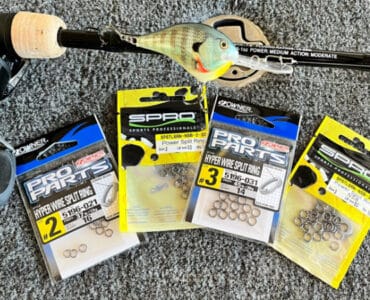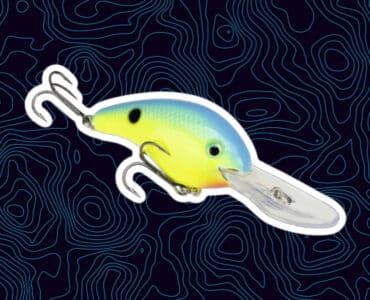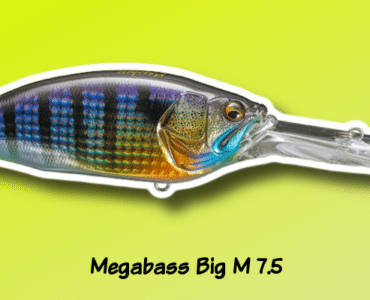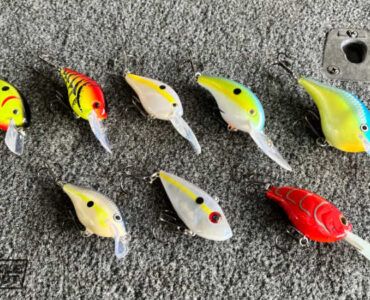Crankbaits and jerkbaits have a lot in common. Both mimic the baitfish and food that bass, walleye, and other freshwater fish pursue. Both are moving baits designed to trigger a reaction strike.
Being similar, how can you tell when to use a crankbait vs. jerkbait?
The key is to understand their differences and when to use each one to your advantage.
This guide will teach unique aspects of each bait and which one to use in the most common conditions.
Key Differences Between a Crankbait and Jerkbait
Crankbaits are round-bodied lures with larger bills for diving to depths of 0 to 25 feet deep and beyond. A jerkbait has a long slender body and short lip, designed to move in short erratic bursts and suspend in depths of 10 feet or less.
Body & Bill Design
One look, and it’s obvious just how different these lures are.
Crankbaits are bulkier and have much larger bills designed for diving quickly.
Jerkbaits are long and skinny, allowing them to dart back and forth in the water, mimicking schooling baitfish.
Crankbaits only have two treble hooks, while most jerkbaits will have three. The exception is very small jerkbaits.
One key thing to notice is the line tie on jerkbaits is on the end of the body, NOT on the bill. This is how the jerkbait can achieve hard side-to-side movements.
Diving Depth
Depending on the type, crankbaits can dive from subsurface to 25ft or deeper. The size of the bill and the weight of the lure will dictate the maximum diving depth.
The goal is to reach the bottom, or at least to the top of any cover, and smash into the objects that fish are holding near.
Jerkbaits have a much narrower window of depth.
- Shallow Jerkbaits – 0 to 3 ft
- Medium Jerkbaits – 4 to 7ft
- Deep Jerkbaits – 7 to 12ft
Yes, you can find jerkbaits that dive deeper than this, but honestly, they start to look and act more like crankbaits at that point.
Action
Crankbaits have a side-to-side wobble action in the water. They usually float, so anytime you stop reeling, the lure will stop moving and appear to hover in place. This sudden change in movement can be deadly on bass.
Jerkbait action is also side-to-side but much more erratic *jerky* fashion. It’s like walking the dog on a topwater but a few feet underwater.
Since they suspend, you can pause the retrieve for as long as you want or can stand it. This is one reason jerkbaits are so effective in cold water and the early/late seasons.
When to Fish a Crankbait vs. Jerkbait
Besides the physical differences, we need to understand how fish relate to crankbaits and jerkbaits.
- Jerkbaits usually work best when fish are feeding UP in the water column. Their eyes are oriented up where the forage is and actively chasing.
- Crankbaits generally work best when fish are feeding near the BOTTOM. Bottom here just means cover – like rocks, sand, brush, wood, and even vegetation.
In each case, we are trying to draw out a reaction bite from the fish. A jerkbait triggers the reaction to CHASE prey, while a crankbait triggers reaction bites by DEFLECTING off cover.
Now let’s see how this can play out in different seasons and weather patterns. These are not rules but a starting point. Let the conditions of the day guide you!
Early Season, Ice Out 👉 Jerkbait
Early in spring, the water is still very cold when the ice first goes out. Fish are still feeling lethargic from a winter hangover.
A jerkbait can be very effective on lethargic early spring fish. When the sun starts to warm the water more, fish feel energized, and the bite can be fantastic.
You can cover tons of water with the jerkbait, even while fishing it slower for the cold conditions.
Prespawn Period 👉 Either
As the water warms above 50°F, the bass will become energized and start feeding heavily in preparation for the spawn.
This a one of the best times for catching trophy bass, and both jerkbaits and crankbaits can come into play. It can vary depending on the type of lake you are on.
Either way, you can target these prespawn fish by identifying the staging areas where fish feed up near spawning flats.
When the Fish are Shallow 👉 Squarebill Crankbait
When fish are near the bank relating to hard cover, it is tough to beat a squarebill crankbait. A squarebill can root through gnarly stuff without snagging that a jerkbait has no hope of coming through.
Worming a squarebill through laydowns is the bread and butter of these types of cranks.
Sandy or rip rap banks is one place where a jerkbait could work well if the squarebill comes up empty.
Spawn Period 👉 Squarebill Crankbait
Bass like to spawn on and next to hard cover like rocks, sand, and wood. A crankbait can work great if there is not too much grass and weeds mixed in.
A bass on a bed is naturally protective and territorial. If a bluegill or crawfish-colored crankbait comes crashing through its bed area, the bass will instinctively bite to eliminate the threat.
Post Spawn Period 👉 Either
After the bass have finished spawning, the larger females will migrate to the next available cover from their bedding areas. This could be a nearby weedline or rocks or the first depth change outside the spawning flats.
Try a jerkbait over the tops of these areas to draw bites from bass that are hanging around recuperating from the spawning period.
A crankbait can work just as well now, if not better. Bass might be feeling a bit lethargic, having expended energy making babies. A medium diving crankbait can be the ticket to enticing reaction strikes.
Cold Front 👉 Jerkbait
When cold weather moves in and the immediate blue bird skies that follow, a jerkbait can shine. Bass can be in a negative mood during and after cold fronts.
A slowly worked jerkbait can entice bites from these fish when a crankbait won’t. Fish your jerkbait as slowly as you can stand it until you figure out how active the fish are.
Windy Conditions 👉 Either
Nothing can fire up a crankbait and jerkbait bite like a stiff wind. It can be annoying to control the boat and cast in these conditions but stick with it, you’ll often be rewarded with some of the best fishing.
Wind creates natural currents and stirs up the lake, stirring up algae and plankton, followed by baitfish. The increased baitfish activity fires up the bite from bass, walleye, crappie, and most other freshwater species.
Slick Calm Conditions 👉 Either
So, the wind is good, slick calm waters must be bad, right? Sure, sometimes there is a lack of fish activity now, especially with sweaty hot temps. But bother jerkbaits and cranks can still be effective.
Crankbaits can get down to bottom hugging largemouth who have moved deeper with the bright sun and calm water.
Smallmouth love the sun, and calm conditions can fire up their sight-feeding instincts. Fishing a jerkbait over deep humps, points, and break lines can produce BIG smallies.
Summertime & Warm 👉 Deep Diving Crankbait
After the fish have recuperated from the spawn and water temps climb over 80, bass seek comfort and food in deeper, cooler waters.
Use your electronics to find rock and bait, holding on to deep cover. Once you’ve located some high potential areas, use a deep diving crankbait to get to their level.
Bump and grind the crankbait over the top of the deep structure to catch these deep fish. Try burning the bait back in as fast as you can, this can be super effective on these fish!
Fall Transition 👉 Both
Fall is all about transition. The lakes are turning over, and bait can be found everywhere. Bass will gang up on bait pods, feeding heavily in preparation for winter.
Once you’ve located the bait, cast shad patterned jerkbaits or crankbaits through the schools to pick off bass.
If the fish are in weed beds, a lipless crankbait is an excellent alternative to a jerkbait or diving crankbait. Ripping a lipless bait over the tops of the grass can trigger bass sitting in pockets and lanes of the vast grass flats.
Wintertime and Cold 👉 Jerkbait
In the winter, bass will move to creek channel swings, steep bluff walls, windy banks, and hard cover that holds warmth like rip rap. All great targets for a jerkbait.
When the water dips below 50 degrees, bass metabolism slows down, and feeding is more of an opportunistic deal.
The great thing about a jerkbait is how slow you can fish it. When fishing a jerkbait in wintertime, slow down, and use longer pauses and softer jerks to coax bites out of sluggish fish.
Dirty Water 👉 Crankbait
Jerkbaits are sight feeding lures. We need decent water clarity for bass to see your lure in the water column.
Crankbaits rely on sound and vibration from rattles and smashing into cover. We are trying to run the lure right in front of the fish’s face. They must choose in an instant whether to bite or get out of the way.
Jerkbaits can be used in stained water, but dingy, muddy water is a tough sell. Put a bright crankbait in your hands when the water gets muddy and grind the bottom.
Will Largemouth Bite a Jerkbait?
Some people might have the wrong impression that fishing jerkbaits is only for smallmouth. This is not true!
Largemouth can be caught on a jerkbait much of the year, especially in the spring and fall when the water temps are still cool or cooling and weeds are not filled in.
Largemouth are looking for easy meals in the spring and are chasing minnows and shad in the fall. These are excellent times to fish a jerkbait.
Will Smallmouth Bite a Crankbait?
Yes, smallmouth will eat a crankbait under the right conditions. If the fish are shallower, on points, humps, big sand flats, and even weed edges a crankbait can catch them.
When those fish transition to deeper dropoffs, that is where the jerkbait shines. The fish will feed upward on baitfish, looking to ambush as the prey comes over the edge of the drop.
Conclusion
As you can see, there are many times when crankbait or jerkbaits can be productive, and sometimes both at the same time!
It’s our job as anglers to read the conditions and figure out which one they want to bite on that day.
The best way to develop a sense of whether to fish a crankbait vs. jerkbait is by putting time on the water and experimenting.
Bottom line, you need to have both baits in your tackle box and be willing to switch when the fish are telling you.














Add comment